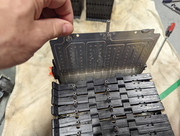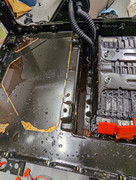Thank you so very much for these photos!
It is very interesting, that at the top of the pack, the liquid appears to be water condensate, yet at the bottom of the pack it is definitely coolant. And the way the silver nuts are corroded, it appears that the condensate has been there for a while. I see that there is a break in a plastic frame at the silver nuts and it almost appears that the brackets for last three cells are "bent up". The white pipes do not look like they have a reliable method of fastening. That one in the center actually looks loose.
It will be interesting to know what else you find.
Thank you again!
It is very interesting, that at the top of the pack, the liquid appears to be water condensate, yet at the bottom of the pack it is definitely coolant. And the way the silver nuts are corroded, it appears that the condensate has been there for a while. I see that there is a break in a plastic frame at the silver nuts and it almost appears that the brackets for last three cells are "bent up". The white pipes do not look like they have a reliable method of fastening. That one in the center actually looks loose.
It will be interesting to know what else you find.
Thank you again!














































